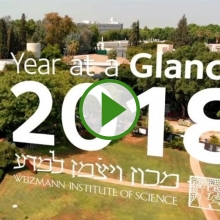Separating informational wheat from chaff
Introducing science teacher Dr. Michal Haskel-Ittah
New scientists

The challenge that the general public faces these days is navigating a bottomless sea of facts and information about science, and determining what is important and reliable. Dr. Michal Haskel-Ittah is developing methods to separate the good information from the bad, or the less relevant.
Dr. Haskel-Ittah is developing more targeted teaching methods by exploring how mechanistic reasoning—the ability to scientifically explain natural phenomena—develops in children and young adults.
She hopes that by discovering which essential scientific facts are necessary to form the building blocks for mechanistic reasoning in children, she will be able to steer science education in a more efficient direction.
The goal: to enable learners to discard superfluous information and home in on key scientific concepts. This method, she believes, will allow them to not only understand how science works, but will give them the tools to extrapolate and, consequently, make better, scientifically based decisions.
“Everyone participates in science in their everyday lives, whether they like it or not,” Dr. Haskel-Ittah says. “They make decisions with a basis in science: whether to vaccinate, or to consume GMO foods, for instance. With the vast amount of information, and bad information, in the world today, it’s even more important for people to have the foundational tools that allow them to identify correct information or faulty information.”
When developing mechanistic reasoning in children is overlooked in school, she adds, material becomes a hodgepodge of useless, memorized facts. This both misrepresents what science really is and hinders students from forming a complete picture that can help in everyday decision-making.
Getting to ‘how’
Dr. Haskel-Ittah developed a new kind of learning environment—a website called “Learning Genetics on the Fly”—which uses fruit fly genetics to give students a more holistic view of genetic mechanisms. Its purpose is just as much about getting students to extrapolate on genetics and hypothesize about gene mechanisms as it is to learn about the fly.
She is now characterizing children’s very first steps of mechanistic reasoning, specifically, how elementary school children explain biological phenomena based on the knowledge they have received in school.
“Young students mainly use ‘intentional reasoning,’” Dr. Haskel-Ittah says. “They explain what or why certain phenomena occur—the intent—rather than how—the mechanics.”
Getting to “how” is the next intellectual leap—and an important one that will pave the way to sophisticated skills. By finding what scientific facts encourage children to hypothesize or even invent mechanisms that could be responsible for the “how” of natural phenomena, she is piecing together the type of information that helps students understand and construct more complex ideas.
Biography
Dr. Michal Haskel-Ittah completed her BSc in life sciences at Ben-Gurion University of the Negev (2007), graduating with distinction. From there, she earned her MSc in 2009 and PhD in 2015 at the Weizmann Institute, where she was in the lab of Prof. Benny Shilo in the Department of Molecular Genetics. She conducted a postdoctoral fellowship in the group of Prof. Anat Yarden, Head of the Department of Science Teaching, and an additional postdoctoral fellowship at Rutgers University in New Jersey before joining the Weizmann Institute in 2020.
She was a recipient of the Combined Weizmann – Abroad Postdoctoral Program for Advancing Women in Science.
Dr. Haskel-Ittah and her husband Daniel have three children, Noam, Omer, and Noga.








